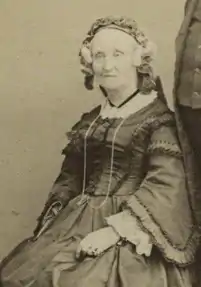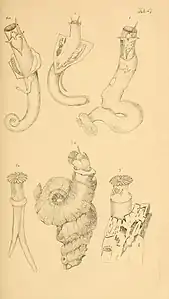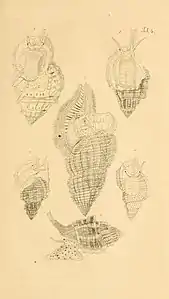Maria Emma Gray
Maria Emma Gray (1787–9 December 1876), was an English conchologist, algologist and scientific illustrator.[1]
Maria Emma Gray | |
|---|---|
 Maria Emma Gray in 1863 | |
| Born | Maria Emma Smith 1787 Greenwich Hospital, London, England |
| Died | 9 December 1876 |
| Occupation(s) | Conchologist, algologist and scientific illustrator |
| Spouses | |
| Children | 2 |
| Parent | Lieutenant Henry Smith |
Family
Her father was Lieutenant Henry Smith, R.N., and he was resident at Greenwich Hospital at the time of her birth.
Life
Gray was born in 1787 at Greenwich Hospital. She married in 1810 Francis Edward Gray, who died four years later, and had by him two daughters, who survived her. Both daughters, Emma Juliana Gray Smith and Sophia Elizabeth Gray Stokes, were also scientific illustrators.[2][3] In 1826 she married his second cousin, John Edward Gray. She greatly assisted her second husband in his scientific work, especially by her drawings. Between 1842 and 1874 she published privately five volumes of etchings, entitled Figures of Molluscan Animals for the use of Students, and she mounted and arranged most of the Cuming collection of shells in the British Museum.
She also made a study of algae, arranging many sets for presentation to schools throughout the country so as to encourage the pursuit of this subject. She worked at both the herbaria at Kew as well as at the British Museum curating algae specimens.[4] Her own collection was bequeathed to the Cambridge University Museum.[5] Her assistance in this branch of her husband's studies was commemorated by him in 1866 in the algae genus Grayemma. Similarly, he named two species of lizards in her honor: Calotes maria and Calotes emma.[6] He also named the species Scapha maria-emma, now known as Cymbiola mariaemma, after her.[7] He went on to have a bronze medallion struck in 1863, bearing both their portraits, a copy of which is in the possession of the Linnean Society. Gray survived her husband by a year, dying on 9 December 1876.
Gallery
_(14593061148).jpg.webp)

 Unidentified
Unidentified_(14779983695).jpg.webp)
References
- "Maria Emma Smith Gray | Shellers From the Past and Present". www.conchology.be. Retrieved 3 February 2021.
- "Gray, Emma J." www.uni-stuttgart.de. Database of Scientific Illustrators, University of Stuttgart. Retrieved 5 September 2018.
- "Gray, Sophia E." www.uni-stuttgart.de. Database of Scientific Illustrators, University of Stuttgart. Retrieved 5 September 2018.
- "Maria Emma Gray | Early Women in Science". earlywomeninscience.biodiversityexhibition.com. Archived from the original on 28 October 2020. Retrieved 2 February 2021.
- Gardiner, Lauren M. (1 January 2018). "Cambridge University Herbarium: rediscovering a botanical treasure trove". Journal of Natural Science Collections. 6: 31–47.
- Beolens, Bo; Watkins, Michael; Grayson, Michael (2011). The Eponym Dictionary of Reptiles. Baltimore: Johns Hopkins University Press. xiii + 296 pp. ISBN 978-1-4214-0135-5. ("Emma Gray", p. 83; "Maria", p. 168).
- Gray, John Edward (1859). "Description of Scapha maria-emma, a New Species of Volute". Proceedings of the Zoological Society of London. 27: 230–231 – via Biodiversity Heritage Library.
![]() This article incorporates text from a publication now in the public domain: George Simonds, Boulger (1890). "Gray, Maria Emma". In Stephen, Leslie; Lee, Sidney (eds.). Dictionary of National Biography. Vol. 23. London: Smith, Elder & Co. p. 11.
This article incorporates text from a publication now in the public domain: George Simonds, Boulger (1890). "Gray, Maria Emma". In Stephen, Leslie; Lee, Sidney (eds.). Dictionary of National Biography. Vol. 23. London: Smith, Elder & Co. p. 11.
External links
- Image of bronze medallion featuring Gray held at the National Portrait Gallery, London.